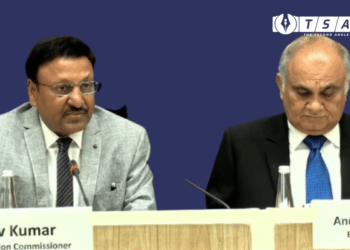The omnipresent strong influence of Deras on Punjab politics has received a fresh lease of life ahead of the Punjab Assembly polls. Union Home Minister, Amit Shah on Wednesday met the chief of Radha Soami Satsang Beas, Baba Gurinder Singh Dhillon, at Beas.
The meeting lasted nearly an hour. Prior to the meeting, a rumour of the Prime Minister meeting the Dera Chief again was dismissed with only Amit Shah’s presence. It is speculated that Amit Shah is eyeing the control these religious sects have over their followers to convince them to vote for Bharatiya Janata Party.

After the meeting, Amit Shah tweeted, “Today I met Radha Soami Satsang chief Baba Gurinder Singh Dhillon. The work being done by Radha Soami Satsang Beas for humanity and social service by continuously awakening spiritual consciousness in society for decades is wonderful and inspiring in itself,” he wrote.
Another development, like the release of Gurmeet Ram Rahim, the controversial figure accused of rape, is on leave for 21 days during the elections, is not looked at as a coincidence by the opposition parties. Though none of the leaders has met Gurmeet Ram Rahim, his Dera has a history of supporting political parties and provides a huge Dalit following, especially in the Malwa region.

Why is there a rise in the number of Deras?
According to Ronki Ram’s article in The Print, there are several socio-political reasons behind this. The erosion of the age-old institution of extended families, the withering of the welfare state, and the widening of inequalities in the wake of neoliberal reforms of the early 1990s, together with continuing caste discriminatory practices, are the issues pointed out in her explanation of what drove them to these Deras.
Rajashekhar dissects the above-mentioned issues at length in his piece in the Scroll. Increasing hardships in agriculture, unemployment and political leaders’ visit to these centres again re-established the strength of these centres.
The idea behind the rise of such institutions indicates the fall of other institutions meant to address the issues plaguing the people of the state.
The electoral significance and influence
The importance and control of Dera’s in Punjab are established through its presence in over 9000 villages out of a total of 13000 villages in Punjab. It becomes an easy, convincing and consolidated approach to get a huge chunk of vote share for the political parties, which is the reason for the leaders of various parties visiting these Deras.
For instance, Gurmeet Ram Rahim’s Dera claims it has 40 lakh followers in Punjab and has influence over at least 40 constituencies, especially in the politically charged Malwa region. The presence of Deras is not limited to Punjab, but also in states like Haryana and Rajasthan. The institution, which started as a religious and social service institution because of their work with the Scheduled Castes and Scheduled Tribes, and Other Backward Castes, and Dalits have become extremely politically influential in Punjab.
There are six major Deras that have their domination in the Punjab elections, which take place in 68 Assembly constituencies. It is divided between Dera Sacha Sauda, which has 27 centres, Radha Soami Satsang Beas has 19 centres, Noormahal Dera (Divya Jyoti Jagriti Sansthan), Sant Nirankari Mission has 4 centres, Dera Sachkhand Ballanhas 8 centres, and Namdhari Sect has 2 centres.
For many years, these Deras have told their followers whom to vote for. There are sanctified political committees inside Deras for this process. This was evidently visible in the 2017 state assembly elections, where the Dera influenced the voters and tacitly supported the Akalis as well as the Congress.
But the Deras are openly not favouring any party this time.
Also Checkout: PM Modi’s Scathing Attack On Nehru For Delaying Goa’s Liberation
















